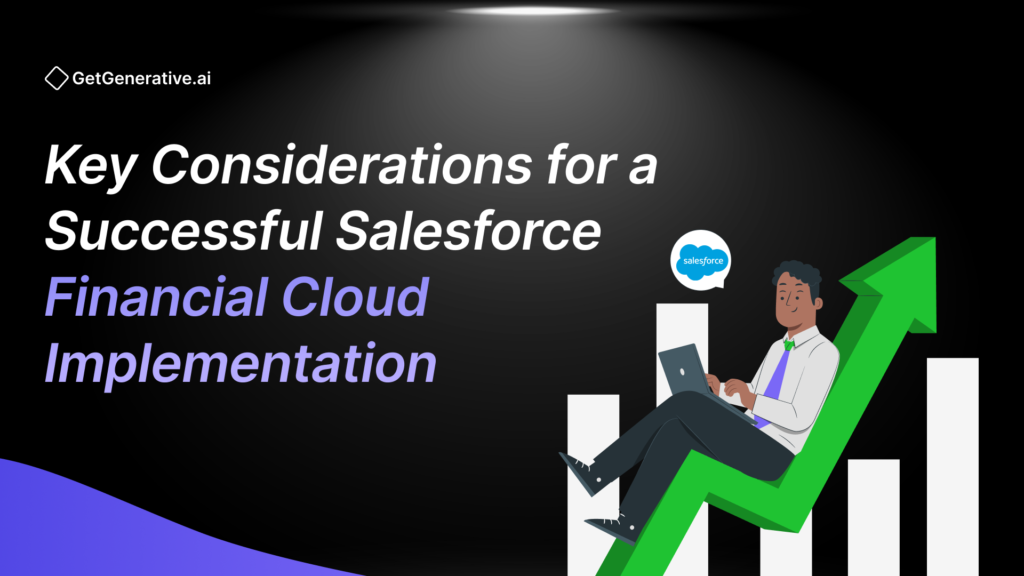Key Considerations for a Successful Salesforce Financial Cloud Implementation
Implementing Salesforce Financial Cloud isn’t a plug-and-play process; it requires careful planning, strategic decision-making, and attention to detail.
Here’s a comprehensive guide to successfully implementing Salesforce Financial Cloud while maximizing its potential for your business.
Key Considerations
Pre-Implementation Planning
- Evaluate Your Business Requirements: Before initiating the implementation process, carefully examine your existing workflows to uncover inefficiencies and identify areas where Salesforce Financial Cloud can provide meaningful improvements.
- Define Clear Objectives: Set specific and measurable goals. For example, aim to improve lead management efficiency by 30% or reduce client onboarding time by 40%.
- Assemble a Cross-Functional Team: Include IT professionals, financial advisors, and project managers to oversee the implementation. A well-rounded team ensures diverse perspectives and expertise.
- Plan for User Licenses: Estimate the number of users and ensure you have the appropriate licenses to avoid disruptions during implementation.
Related Read – Salesforce Financial Cloud Implementation Guide
Data Management and Migration
- Prioritize Clean Data: Data is the backbone of any CRM. Begin by cleaning and deduplicating existing data to ensure accuracy and consistency. A well-maintained data set enhances decision-making and user trust in the system.
- Begin Data Planning Early: Data migration is a critical step in implementation. Address it proactively during the initial phases to avoid delays and complications later.
- Test Migration Thoroughly: Load test data before going live. This helps identify and fix potential issues with data integrity and system compatibility.
Customization and Configuration
- Tailor the Platform to Your Needs: Salesforce Financial Cloud comes with robust out-of-the-box capabilities, but every business has unique requirements.
- Avoid Over-Customization: While customization is essential, excessive modifications can complicate updates and increase costs. Strike a balance by prioritizing essential customizations.
Integration with Existing Systems
Evaluate Integration Points: Determine which systems need to connect with Salesforce Financial Cloud. These might include transactional platforms, external databases, or third-party applications.
Choose the Right Integration Method
- APIs: Use Salesforce’s pre-built APIs
- Connectors: Tools like MuleSoft simplify integration with minimal effort.
- Custom Integrations: Hire a Salesforce developer for highly specialized integration needs.
User Training and Change Management
- Educate Your Team: Hands-on workshops and online tutorials can be invaluable.
- Address Resistance to Change: Employees may resist new technology due to fear of complexity or unfamiliarity. Foster open communication, highlight benefits, and involve users early in the process to build trust.
Ensuring Compliance and Security
- Ensure Compliance with Regulatory Standards: While Salesforce Financial Cloud is built to align with global regulations like GDPR and CCPA, it’s essential to confirm that your implementation adheres to specific regional compliance requirements.
- Strengthen Data Access Controls: Implement role-based access mechanisms to restrict data access to authorized personnel, reducing the likelihood of security breaches and safeguarding sensitive information.
- Use Salesforce Shield: This feature provides encryption and enhanced monitoring, ensuring your data remains secure both at rest and in transit.
Also Read – Key Features of Salesforce Financial Services Cloud
Testing and Quality Assurance
- Run Pilot Tests: Before a full-scale launch, conduct pilot tests with a small group of users.
- Simulate Real Scenarios: Use real-world data and scenarios during testing to ensure the system meets your business requirements.
Post-Implementation Support
- Monitor Performance: After going live, track key metrics like system uptime, user adoption rates, and operational efficiency. Regular monitoring helps identify areas for improvement.
- Leverage Salesforce Support: Salesforce offers continuous updates and customer support.
Measuring ROI and Success
- Track Key Performance Indicators (KPIs): Measure success by monitoring KPIs such as client satisfaction scores, revenue growth, and process efficiency improvements.
- Evaluate Long-Term Benefits: Assess whether Salesforce Financial Cloud is helping you achieve your strategic objectives, such as better client retention or improved compliance.
Conclusion
Implementing Salesforce Financial Cloud is a strategic investment that can transform financial operations and enhance client experiences. You can ensure a successful implementation that drives measurable results by following these considerations—data preparation, thoughtful customization, robust training, and compliance focus.
For more, visit GetGenerative.AI
FAQs
1. What is Salesforce Financial Cloud used for?
Salesforce Financial Cloud helps financial institutions manage client relationships, automate workflows, and ensure regulatory compliance.
2. How long does implementation typically take?
The timeline varies but generally ranges from 3 to 12 months, depending on complexity and customization.
3. Is customization mandatory for Salesforce Financial Cloud?
While not mandatory, customization helps align the platform with your specific business needs for maximum efficiency.




